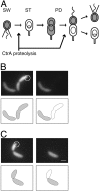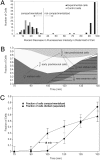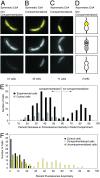Fluorescence bleaching reveals asymmetric compartment formation prior to cell division in Caulobacter
- PMID: 12824468
- PMCID: PMC166212
- DOI: 10.1073/pnas.1433105100
Fluorescence bleaching reveals asymmetric compartment formation prior to cell division in Caulobacter
Abstract
Asymmetric cell division in Caulobacter crescentus yields daughter cells that have different cell fates. Compartmentalization of the predivisional cell is a critical event in the establishment of the differential distribution of regulatory factors that specify cell fate. To determine when during the cell cycle the cytoplasm is compartmentalized so that cytoplasmic proteins can no longer diffuse between the two nascent progeny cell compartments, we designed a fluorescence loss in photobleaching assay. Individual cells containing enhanced GFP were exposed to a bleaching laser pulse tightly focused at one cell pole. In compartmentalized cells, fluorescence disappears only in the compartment receiving the bleaching beam; in noncompartmentalized cells, fluorescence disappears from the entire cell. In a 135-min cell cycle, the cells were compartmentalized 18 +/- 5 min before the progeny cells separated. Clearance of the 22000 CtrA master transcriptional regulator molecules from the stalked portion of the predivisional cell is a controlling element of Caulobacter asymmetry. Monitoring of a fluorescent marker for CtrA showed that the differential degradation of CtrA in the nascent stalk cell compartment occurs only after the cytoplasm is compartmentalized.
Figures



References
-
- Ryan, K. R. & Shapiro, L. (2003) Annu. Rev. Biochem. 72 367-394. - PubMed
-
- Shapiro, L., McAdams, H. H. & Losick, R. (2002) Science 298 1942-1946. - PubMed
-
- Poindexter, J. S. & Hagenzieker, J. G. (1981) Can. J. Microbiol. 27 704-719. - PubMed
-
- Quardokus, E. M., Din, N. & Brun, Y. V. (2001) Mol. Microbiol. 39 949-959. - PubMed
Publication types
MeSH terms
Substances
Grants and funding
LinkOut - more resources
Full Text Sources

